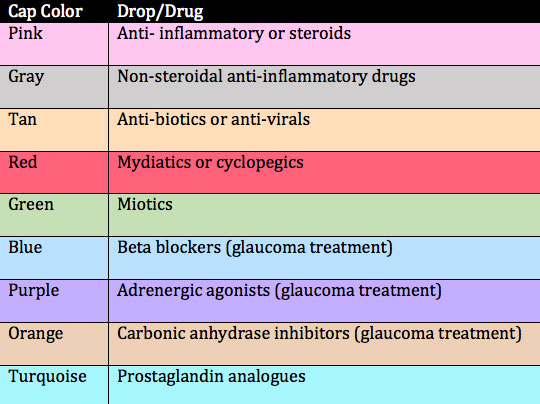As discussed in my previous article, the importance of understanding and knowing the names of widely used eye drops is vital. With the amount of medical problems being treated and post-operative care that optometric and ophthalmic offices provide, it is extremely important to know your medications and the common dosages. It is also important for the patient to understand the medications they are using.

This can get complicated, especially if you have patients using more than one eye drop. The color coding of the tops of the bottles is a huge help. The color-coding of bottles started in 1996 with the help of the AOA and the FDA.
The color-coding of the eye drops allows the ophthalmic staff to know what drops a patient could be using. Patients may not know the names of the eye drops that they use, but most can remember the color of the tops. So if a patient says their eye drop has a yellow top, you know they are being treated for glaucoma with a beta blocker. If they are using a pink top drop, they are being treated with a steroid. You may not know the exact medication that is being used, but just by knowing the color top of the medication, it can help determine what medical problems the patient is being treated for.
Not only is this useful for the optometric assistant and doctor, but color-coding is very useful with patient compliance. It is much easier to instruct patients of their eye drop use by mentioning the color of the tops. Post- operative care can be especially over whelming. Having the color tops listed on written instructions for the patients can help the patient remember not only which drop should be used, but also can help remind them how many times daily the drops should be used.
Treatment of eye disease and medical problems of the eye can at times be complex and confusing. Any way to simplify a patients treatment can be greatly appreciated and help with patient compliance. This will allow the patient to have the best possible care for their eyes.

Linda Hardy is a Certified Optometric Technician and Certified Ophthalmic Assistant. She is also ABO certified and NCLE certified and a Licensed Dispensing Optician in the state of Georgia. She has been with a private optometry practice in Newnan, Georgia for 15 years as the clinical coordinator.
Linda graduated from Georgia Medical Institute as a Registered/Certified Medical Assistant in April 1996. She began working with a group of ophthalmologists as an ophthalmic assistant. She switched her career to optometry in 1999. She has had the opportunity to become knowledgeable in many areas of the eye field from assisting to opticianry.












